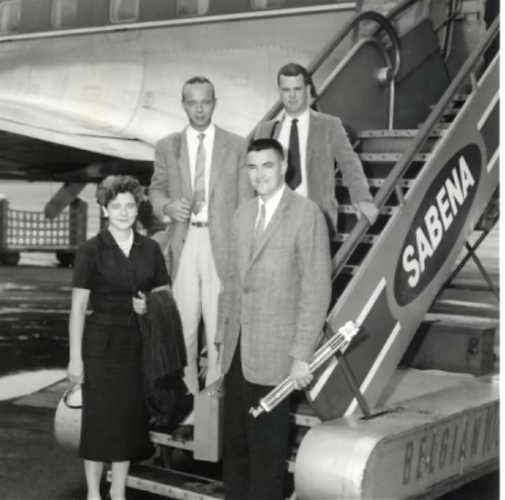
JRH
Regulars-
Posts
449 -
Joined
-
Last visited
-
Days Won
33
Content Type
Forums
Events
Gallery
Everything posted by JRH
-
1940s Heritage speaker set PRE Klipsch with Paul's Blueprints
JRH replied to klipsch curious's topic in Ask the Historian
PWK shared his blueprints with many in the beginning. He ceased the practice fairly soon, as most home builders screwed it up. I would guess these to be made between 1946 and 1949. They certainly should be preserved! I'd love to see some pics from the back side. I'd also like to get the name of your grandfather, as there could be correspondence in our files. If you'd rather not post this info on the Forum, you can send it to jim@klipschmuseum.org. -
Made in Hope
-
Stinson Voyager Cessna 190 Cessna 180 Bonanza A-35 V-tail Beech Travelair Beech Baron
-
276 shipped 11 Oct 1961. The Model H was the name given to the Heresy "from the beginning", but it didn't come out of the closet until well into the 60's due to several Southern Baptist employees' qualms about using it.
-
These shipped 2/23/1983 to "Canada".
-
HIP-BB shipped to DMC on 4/15/83.
-
Klipsch currently uses a custom lacquer based finish. I'd use a lightly dampened cloth.
-
The Music Box, Wellesley--seeking information
JRH replied to Rivendell61's topic in Ask the Historian
Thanks, Travis! I have responded to Cathy's email. Quite interested in this chapter of Klipsch heritage. Attached is Bill's credo, and a poor resolution pic of him arriving at the Brussels World's Fair in 1958 (top right). -
Sorry for the delayed entry into the conversation. 1980 was a Hell of a year for Heresy's. Mid-September thru November saw over 3600 shipped. In those, only a handful carried the HWLG designation. There were also a handful of HOLG. I would agree that "Gloss" is the likely meaning.
-
The first logbook notation of a K-700 was 1D030 shipped 20 May 1966. There was a transition period until at least 1D169 shipped 29 Nov 1966 with possibly the last K-1000. The first "C" callout was 1D135 shipped 4 Nov 1966. The network chart dated 661024 shows a C, C-2, and C-3. These were to accommodate differing levels of tweeters. Previously with the K-1000, the 4RB was for tweeters at standard level, the 4B was for tweeters with + 3dB sensitivity, and the 4QB was for tweeters with - 3dbB levels.
-
Need a pic of the labels.
-
It appears from the logbook that woofer access from the bottom began with 3M017 on 2/14/75. There is an earlier reference to a "special LS-BR with new style - door on the bottom - we built this on a Saturday". That was SN 2M784 on 12/14/74. 2M838 & 9 shipped 12/23/74, with no destination specified. The top filled holes remind me of special units sold to Rogers Organ with removable tops so they could install an amplifier. One of those could have been a "donor" to this unit (just speculation). The Rogers units became Klipsch's first powered speakers.
-
I do not have records "this new". Check the chart posted at the top of this forum.
- 1 reply
-
- 1
-

-
426 shipped to K.L.A Labs. 490 went to Sterling Radio Products Co. of Houston. 426 had the Stephens P-52 LX woofer, University SAHF mid, and University 4401 tweeter. 490 had the same mid and tweet, but with a Stephens 103 LX2 woofer. Interesting that both shipments included a Rebel.
-
I suspect replacement parts may be difficult, but that will need to be answered by Klipsch Customer Service (ask for Trey).
-
Not that I know of.
-
Question Re: LSI date and Info [moved from other thread]
JRH replied to Netsrac's topic in Ask the Historian
The only "1050" and "1052" I can find are for LSI-BBTS-LF's. If these speakers are unitary construction (not split HF and LF) I don't believe we have a record. -
A very few "Tremulant" Klipschorns were offered. I haven't counted them in the logbook which would be a significant "project". However, I believe less than 20 were built. The museum has one courtesy of eBay. The paddle was driven by a turntable motor mounted in the back of the HF module.
-
1E166 was the last recorded serial number, so 666 in total seems to be correct. At the beginning of the logbook it says: "Began giving serial numbers to assembled Shorthorns both decorated and utility. Started on 25 Jan 56 with ser. # 501". That COULD imply that un-serialized units exist.
-
Without actually measuring one I can't say with 100% certainty. However, the T2A drops the thru-put in 3 dB steps (-3, -6, -9, -12). Its very likely that PWK needed a further 3 dB drop (-12), resulting in the "A" suffix.
- 1 reply
-
- 2
-

-
- 1 reply
-
- 2
-

-

-
Checking with Gary Gillum, the resin included black pigment. Areas that were not glassed (LS and MWM interiors) got the standard black lacquer. In the case of the 260 horn, black gel coat was applied to the mold prior to layering with glass and black pigment.
-
1265 and 1266 are listed as slant monitors (angled cabinet) and were shipped 5/23/78 to Chujko Bros. 1267 and 1268 are listed as HIP's (ported rectangular cabinet) and were shipped the same day to Turntables Unlimited.
-
I couldn't tell you an exact color specification, however, I suspect it was the "same black" lacquer used for basically everything else. Aluminum trim was purchased from Macklanburg-Duncan. They still offer some trim, but I'm not sure about the "odd angle" for the LS doghouse. https://mdbuildingproducts.com
-




